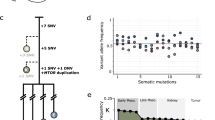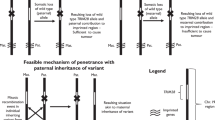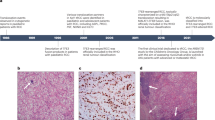Abstract
Nephrogenic rests consist of foci of primitive renal cells, typically microscopic, that are found within the normal kidney tissue of children with Wilms' tumour. To study the relationship between nephrogenic rests and the associated tumours, we screened these lesions for mutations in the 11p13 Wilms' tumour suppressor gene, WT1. In two cases in which the Wilms' tumour contained a somatic WT1 mutation, the nephrogenic rest had the identical mutation. Nephrogenic rests and Wilms' tumours are therefore topographically distinct lesions that are clonally derived from an early renal stem cell. Inactivation of WT1 appears to be an early genetic event which can lead to the formation of nephrogenic rests, enhancing the probability that additional genetic hits will lead to Wilms' tumour.
This is a preview of subscription content, access via your institution
Access options
Subscribe to this journal
Receive 12 print issues and online access
$209.00 per year
only $17.42 per issue
Buy this article
- Purchase on SpringerLink
- Instant access to full article PDF
Prices may be subject to local taxes which are calculated during checkout
Similar content being viewed by others
References
Beckwith, J., Kiviat, N. & Bonadio, J. Nephrogenic rests, nephroblastomatosis and the pathogenesis of Wilms' tumor. Ped. Pathol. 10, 1–36 (1990).
Bove, K. & McAdams, A. Multifocal nephroblastic neoplasia. J. natn. Cancer Inst. 61, 285–294 (1978).
Bove, K. & McAdams, A. The nephroblastomatosis complex and its relationship to Wilms' tumor: a clinicopathologic treatise. Perspect. pediatr. Pathol. 3, 185–223 (1976).
Knudson, A. & Strong, L. Mutation and cancer: a model for Wilms' tumor of the kidney. J. natn. Cancer Inst. 48, 313–324 (1972).
Haber, D. & Housman, D. The genetics of Wilms' tumor. Adv. cancer Res. 59, 41–68 (1992).
Call, K. et al. Isolation and characterization of a zinc finger polypeptide gene at the human chromosome 11 Wilms' tumor locus. Cell 60, 509–520 (1990).
Gessler, M. et al. Homozygous deletion in Wilms' tumours of a zinc-finger gene identified by chromosome jumping. Nature 343, 774–778 (1990).
Pritchard-Jones, K. et al. The candidate Wilms' tumour gene is involved in genitourinary development. Nature 346, 194–197 (1990).
Buckler, A., Pelletier, J., Haber, D., Glaser, T. & Housman, D. Isolation, characterization, and expression of the murine Wilms' tumor gene (WT1) during kidney development. Molec. Cell Biol. 11, 1707–1712 (1991).
Haber, D. et al. An internal deletion within an 11p13 zinc finger gene contributes to the development of Wilms' tumor. Cell 61, 1257–1269 (1990).
Cowell, J. et al. Structural rearrangements of the WT1 gene in Wilms' tumor cells. Oncogene 6, 595–599 (1991).
Ton, C. et al. Smallest region of overlap in Wilms' tumor deletions uniquely implicates an 11p13 zinc finger gene as the disease locus. Genomics 10, 293–297 (1991).
Little, M. et al. Zinc finger point mutations within the WT1 gene in Wilms' tumor patients. Proc. natn. Acad. Sci. U.S.A. 88, 4791–4795 (1992).
Huff, V. et al. Evidence for WT1 as a Wilms' tumor (WT) gene: intragenic germinal deletion in bilateral WT. Am. J. hum. Genet. 48, 997–1003 (1991).
Pelletier, J. et al. WT1 mutations contribute to abnormal genital system development and hereditary Wilms' tumour. Nature 353, 431–434 (1991).
Pelletier, J. et al. Germline mutations in the Wilms' tumor suppressor gene are associated with abnormal urogenital development in Denys-Drash syndrome. Cell 67, 437–447 (1991).
Henry, I. et al. Tumor-specific loss of 11 p15.5 alleles in del 11p13 Wilms' tumor and in familial adrenocorical carcinoma. Proc. natn. Acad. Sci. U.S.A. 86, 3247–3251 (1989).
Riccardi, V., Sujansky, E., Smith, A. & Francke, U. Chromosomal imbalance in the aniridia-Wilms' tumor association: 11 p interstitial deletion. Pediatrics 61, 604–610 (1978).
Wiedemann, H. Complexe malformatif familial avec hernie ombilicale et macroglossie—Un syndrome nouveau? J. Genet. hum. 13, 223–232 (1964).
Beckwith, J. Macroglossia, omphalocele, adrenal cytomegaly, gigantism and hyperplastic visceromegaly. Birth Defects 5, 188–196 (1969).
Bove, K.E. & Kiser, B. AgNOR counts in multicentric Wilms' tumor distinguish maturing, dormant and expanding cell populations. Lab. Invest. 64, 2A (1991).
Pritchard-Jones, K. & Fleming, S. Cell types expressing the Wilms' tumour gene (WT1) in Wilms' tumour: implications for tumor histogenesis. Oncogene 6, 2211–210 (1991).
Mulvihill, D.M., Mercado, M.G. & Boinaeau, F.G. Beckwith-Wiedemann syndrome and its association with Type II polycystic kidney disease. Pediatr. Nephrol. 3, 286–289 (1989).
Haber, D. et al. Alternative splicing and genomic structure of the Wilms' tumor gene WT1. Proc. natn. Acad. Sci. U.S.A. 88, 9618–9622 (1991).
Orita, N., Iwahana, H., Kanazawa, H., Hayashi, K. & Sekiya, T. Detection of polymorphisms of human DNA by gel electrophoresis as single-strand conformation polymorphisms. Proc. natn. Acad. Sci. U.S.A. 86, 2766–2770 (1989).
Haber, D., Timmers, H., Pelletier, J., Sharp, P. & Housman, D. A dominant mutation in the Wilms' tumor gene WT1 cooperates with the viral oncogene E1A in transformation of primary kidney cells. Proc. natn. Acad. Sci. U.S.A. 89, 6010–6014 (1992).
Sidransky, D. et al. Clonal origin of bladder cancer. New Engl. J. Med. 326, 737–740 (1992).
Fearon, E. & Vogelstein, B. Agenetic model for colorectal tumorigenesis. Cell 61, 759–767 (1990).
Costanzi, E., da Silva Fernandes, M. & Erwenne, C. Esterase D in retinoma. Ophtalmic paed. Genet. 10, 157–160 (1989).
Balmer, A., Munier, F. & Gailloud, C. Retinoma case studies. Ophthalmic paed. Genet. 12, 131–137 (1991).
Haber, D. & Housman, D. Rate-limiting steps: the genetics of pediatric cancers. Cell 64, 5–8 (1991).
Author information
Authors and Affiliations
Rights and permissions
About this article
Cite this article
Park, S., Bernard, A., Bove, K. et al. Inactivation of WT1 in nephrogenic rests, genetic precursors to Wilms' tumour. Nat Genet 5, 363–367 (1993). https://doi.org/10.1038/ng1293-363
Received:
Accepted:
Issue Date:
DOI: https://doi.org/10.1038/ng1293-363



